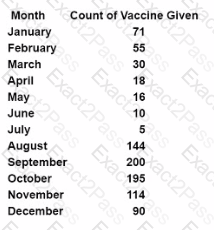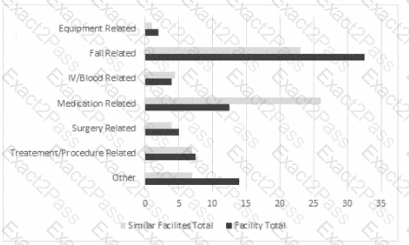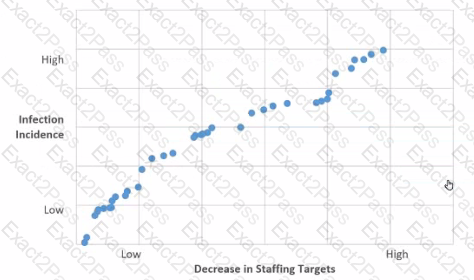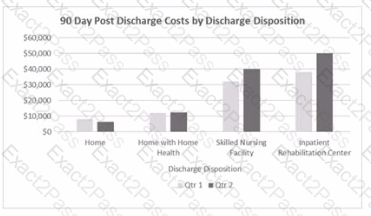The health department cited a clinic for storing used instruments improperly. From a quality perspective, which of the following should be done first?
An ambulatory care practice has reviewed data to identify patients with multiple visits to the emergency room within the last six months. The population health management technique for this type of data review is called
The collection, analysis, and Interpretation of data for planning, Implementing, and evaluating health programs is
Which of the following Is an algorithm that Is designed to classify patients according to their acuity?
Data for an organization's annual Influenza vaccine administration yields the following results:

What is the median for the organization's annual vaccine count?
An organization Is shirting paradigms from top-down leadership to participatory management. The process of moving forward Includes the four Identified phases below:
1. gathering baseline data
2. evaluating effectiveness and Improvement
3. making the commitment
4. Implementing the program
Which of the following Is the most logical sequence for these phases?
Which of the following data sources can be used to assess a population's health status?
Which of the following is the best strategy for executive leaders to improve patient safety within an organization?
A hospital installed a new patient safety event reporting system. During the failure modes and effects analysis (FMEA), decreased use of the system and complexity of reporting were identified as potential failures. What should the team use to determine which failure mode to address first?
An organization recently completed an analysis of safety events from the last year. The majority of events were related to the following:
• provider order transcription errors (5%)
• wrong medication given to the patient (12%)
• adverse reaction related to medication allergies (7%)
• Inappropriate medication dose administered (10%)
• delayed antibiotic administration (10%)
Which of the following would be most helpful to enhance patient safety In this organization?
Data from an Incident reporting system compares Incident rates for one facility to similar facilities:

After reviewing the graph, which of the following should be done first?
Analysis has shown that there Is a significant delay in receiving laboratory results In the emergency room. A cross-functional team Is assigned the task of Improving laboratory reporting time. Which of the following Is the next step the team should take?
Which of the following tools provides the best way to display quarterly comparisons of patient satisfaction surveys?
Who is responsible for aligning resources and ensuring accountability in an improvement project?
Choosing a small number of items to represent characteristics of the whole is an example of
Evaluating data to determine high utilizers of emergency departments and their related characteristics is a strategy that can best help with
In order to make effective long-term changes, performance Improvement emphasizes the need to study and understand
A quality professional needs to select a new project from a list of requests. An organization has determined that new projects should focus on patient safety and cost-reduction. Which tool would help Identify the project that best meets these criteria?
An emergency department's quality Improvement report for the first quarter showed the following data:

What was the approximate overall problem rate for March?
Which type of data could best be used to help identify health-determinant information in a patient population?
Which of the following is used to assess points of vulnerability within a process?
Which of the following should be a part of an organization's program of continuous readiness for accreditation?
One of the first steps in preparing for an organizational accreditation survey Is to have a quality professional
In reviewing information offered by the Agency for Healthcare Research and Quality (AHRQ), the quality improvement (QI) specialist recognizes that the three broad aims pursued by the National Quality Strategy are
In an aging population, one of the challenges associated with the use of practice guidelines is
A quality Improvement team has Identified specific changes to Implement for a quality Improvement Initiative. As the next step, the team would like to establish a concrete timeline for implementation. Which of the following is the best tool to use for this step?
Which of the following are the three primary quality management activities?
Which of the following tools would best display nosocomial infection rates over time?
Which of the following best describes how a quality professional should conduct an organizational assessment to ensure safe transitions of care?
A performance improvement coordinator is having difficulty keeping a new team focused on its goal of decreasing patient waiting times. To understand why the team process is not working, the team leader should initially assess the
A multidisciplinary team has been convened to review delays in laboratory turnaround time between the medicine clinic and the laboratory. The team’s first step in evaluating the issue is to
The hospital administration has requested data to support an initiative to reduce barriers to healthcare In the community. Which of the following Information Is most appropriate for the quality professional to provide for initial planning?
A nursing director for a unit in a cancer hospital Is reviewing and assessing outcomes data in the following scatter diagram:

The relationship between the incidence of infection and the decrease in staffing targets is
Which of the following should a healthcare plan use to collect satisfaction data from its health plan members?
The quality Improvement (Ql) specialist recognizes that any documents related to medical peer review are
A local health center is launching a community health assessment. What data is recommended to identify the potential needs of the population?
A CEO has directed a quality improvement council to develop objectives to meet an identified goal. When developing objectives, the council must remember to
Where in the process of ensuring correct surgery does a "time-out" take place?
In aligning an organization's performance Improvement plan with strategic goals, a healthcare quality professional should consider
During the course of a root cause analysis, the team found the following Items contributed to the error:
• Fatigue and stress leading to Inattention
• Pressure to accomplish more tasks In the same amount of time
• The equipment was designed for right-handed staff
Which of the following best describe these types of causes?
Before patient outcome data can be used for benchmarking, the data should be
An improvement project was implemented to expand utilization of primary care services in a rural area where only 5% of residents sought primary care. The team established a goal of 20% of residents using primary care. The table below shows the results for the four months following implementation of the improvement:
% Residents Using Primary Care
Time | %
Baseline | 5%
Month 1 | 15%
Month 2 | 20%
Month 3 | 21%
Month 4 | 22%
Which of the following should the quality professional recommend to the organization?
Which of the following Is the best approach to prepare care team members tor Interacting with accreditation surveyors?
A performance improvement council has been directed to set up a communication plan for spreading an innovative telehealth program throughout the healthcare system. Which of the following groups must the council include in the communication plan?
The strategic plan for an organization calls for expansion of information technology. The following information is available:

If equal weight is given to each consideration, which of the following options should be the primary choice?
Members of a performance improvement team voice complaints about not having as much decision-making authority as they expected. Which of the following should be developed to decrease the likelihood of such complaints?
Over the past 2 months, a trend has been detected in medication errors. The preferred method of presenting data to the nursing Quality Council will identify the nurse by
In a healthcare organization Implementing ongoing performance Improvement (PI), which of the following will most likely benefit the PI goals of the organization?
A healthcare quality professional's initial step in the creation of a patient safety program is to
While the use of technology may result in fewer medical errors. In order for this strategy to be most effective. It should be supported by
A hospital has been experiencing a significant Increase in the number of medication errors. The hospital's governing board has adopted barcoding technology with electronic documentation at the point of care. Which of the following medication errors will most likely be reduced by the Implementation of this technology?
Technology design that prevents a certain action, or requires that another action happen first, is said to have
A performance improvement specialist at an ambulatory surgery center is facilitating a Plan-Do-Study-Act Cycle (PDSA) process to improve the rate of hand hygiene amongst surgical post-recovery staff to 90% or above. Data from the past 12 months are as follows:
Baseline: 60% compliance
Q1: 87% compliance
Q2: 79% compliance
Q3: 91% compliance
Q4: 72% compliance
The specialist is preparing to discuss aggregate results with the Quality Committee. To most accurately convey the results, the specialist highlights the
Managed care outcomes related to HEDIS measures are most commonly obtained through
The healthcare quality professional has been asked to participate in the organizations population health program related to cost and utilization.

Based on this Information, what Is the next action the quality professional should take?
A performance Improvement team has been meeting to examine delays in getting admissions from the emergency room to the nursing units. After six months of collecting data, the upper control limit was ISO minutes, and the lower control limit was 60 minutes. The next month's data shows a time of 155 minutes. The team should understand that this represents what type of variation?
A hospital is considering changing the process of admissions from the emergency department. To support patient safety when this new process is deployed, the healthcare quality professional should suggest which of the following actions during the design stage of the process?
An organization has Implemented a quality improvement project. The goal is a mean compliance rate of 90%. The results of observations are found in the table below:

Which focus area presents the greatest opportunity for the organization?
A home health agency’s Performance Improvement Committee has decided to base staff educational programs on aggregated occurrence report data. Due to budgetary and time constraints, not every area identified from the data can be addressed. Which of the following would be most useful to the committee in determining their educational targets?
An orthopedic surgery practice has been working on improving patient safety for the last 3 years. The following data table is available:

Which of the following is the most appropriate conclusion about patient safety outcomes?
A local health center is launching a community health assessment. What data is recommended to identify the potential needs of the population?
An important responsibility of each team member working on a team project is to
A healthcare quality professional is conducting a study to determine how many patients contracted influenza despite receiving flu shots. This study is evaluating
The healthcare quality professional is tasked with monitoring the monthly fall rates. The fall rate that requires the most immediate investigation is
Which of the following best describes how a quality professional should conduct an organizational assessment to ensure safe transitions of care?
The expectation to maintain continuous survey readiness must be supported and driven by the
A director at a large health system is tasked with building a new population health program. What is the director’s first step?
Which of the following best describes the purpose of the nominal group technique?
Which management accountability action should be Implemented to ensure continuous readiness tor accreditation survey?
A quality professional Is the leader of a team in the storming phase of development Which of the following should the quality professional be prepared to do?
Why is it important to convene a multidisciplinary team when conducting a failure mode and effects analysis (FMEA)?
A team has identified that labeled cutting boards are needed in a kitchen to decrease cross-contamination. After a new process has been implemented, it is discovered that the labeled cutting boards are not being used. Which of the following is the next action the team should take?
A rapid cycle improvement team has met for six months. The team set a clear aim, gathered data, and identified barriers, but has not conducted any tests of change. Team members are also not completing assignments. Which of the following tools should be used to get the team back on track?